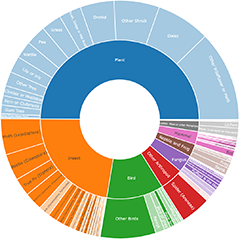Announcements
24 Sep 2025
Hi NatureMapr Data Collector app users,If you experience the following error when attempting to upload sightings from the NatureMapr Data Collector mobile app, please note the following known issue an...
Continue reading
NatureMapr moves to simpler, flatter national structure
Mobile App update and known issues
Discussion
Liam.m
wrote:
7 min ago
Hi DonB, thanks for your sighting. The media you provided is missing or unclear. To help us verify this sighting, please provide additional media.
Unverified Bird of prey
chriselidie
wrote:
14 min ago
The reason I thought that this might be a female is because it was the only one of 10 similar moths hatched so far without pectinations on the antennae. Also different is that I found it hanging off its container roof exposing its abdomen and wafting a tube-like attachment (like an ovipositor? - shown in some of the pictures) through the air. This one was also the only one that was not eager to get going - it seems too heavy to fly very far. It was still resting under a tree, so I could take more photos. It wouldn't let me touch its wings, but has positioned itself a bit better now - hope these photos (no 1 and 2) are of more help.
Ectropis (genus)
WendyEM
wrote:
56 min ago
An important feature that separates E. excursaria from similar species is that the main dark line running across the hindwing is fairly straight but turns upward as it approaches the edge of the wing, and has a step at the end. This part of the line is not visible in live shots. The forewings need to be further open - which you can sometimes do by gently nudging the wing across with a stick maybe your finger. It depends how flighty the moth is. Another feature is the male's antennae. Your moth could be Ectropis bispinaria in which the male antennae have very short, fine pectinations. (E. excursaria also has fine short pectinations but they are a bit longer) I think I can see very short pectinations on your moth. I am not an anatomist but I think this is a male moth ? Your sightings are very important as you have raised them through so we are trying to get this right.
Ectropis (genus)
DianneClarke
wrote:
1 hr ago
Thanks Wendy - have it in a jar so time will tell if I find out which one it is.
Pararguda (genus)
Significant sightings
- Paraselina brunneri at Nightcap, NSW
- Paropsis pantherina at Broke, NSW
- Galadistes pilligaensis at The Pilliga, NSW
- Callocephalon fimbriatum at Aranda, ACT
- Daphnandra micrantha at Pappinbarra, NSW
- Litoria raniformis
- Keyacris scurra at Penrose, NSW
- Callocephalon fimbriatum at Hughes, ACT
- Perunga ochracea at Yarralumla, ACT
- Keyacris scurra at Williamsdale, NSW
Top contributors
- AlisonMilton 17.2K
- trevorpreston 16.2K
- Hejor1 15.1K
- Tapirlord 12.1K
- Mike 10.9K
- MichaelBedingfield 10.8K
- RodDeb 10.5K
- kasiaaus 9.9K
- ConBoekel 9.8K
- KylieWaldon 9.2K
Top moderators
- MichaelMulvaney 61.3K
- Tapirlord 41.7K
- MichaelBedingfield 23.8K
- Liam.m 22.4K
- donhe 18.3K
- natureguy 15.7K
- ibaird 15.5K
- MatthewFrawley 12.3K
- AlisonMilton 11.1K
- plants 9.1K















































































































